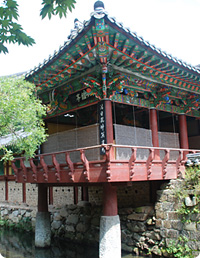PACKAGE
Off The Beaten Path 10 days
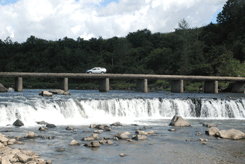
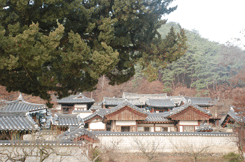
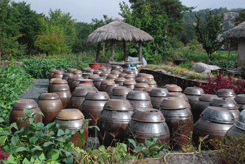
Tour Highlights
- Gyeongbokgung Palace
- National Folk Museum of Korea
- Insadong
- Gwangjang Market
- N Seoul Tower
- Peace Dam
- Eulji Observatory
- The 4th Tunnel
- Seoraksan National Park
- Woljeongsa Temple
- Chamsori Museum
- North Korean Submarine
- Jeongdongjin Station
- Hwanseongul Cave
- Dosanseowon Confucian Academy
- Hahoemaeul Village
- Ganggu Fishing Port
- Jukdo Fish Market
- Seokguram Grotto
- Bulguksa Temple
- Gyeongju National Museum
- Donggung Palace and Wolji Pond
- Cheomseongdae Astronomical Observatory
- Tumuli Park
- Bunhwangsa Temple
- Tongdosa Temple
- Haeundae Beach
- UN Memorial Cemetery
- Yongdusan Park
- Jagalchi Fish Market
Click on the days to access the program quick
| Days | Visits and Activities | Distance |
| Day 1 | Arrive Seoul | 60km |
| Day 2 | Seoul | |
| Day 3 | Seoul - Hwacheon - Haean - Seoraksan | 300km |
| Day 4 | Seoraksan | |
| Day 5 | Seoraksan - Yangyang - Girin - Jinbu - Gangneung | 220km |
| Day 6 | Gangneung - Jeongdongjin - Dosan - Andong | 220km |
| Day 7 | Andong - Hahoe - Yeongdoek - Pohang - Gyeongju | 230km |
| Day 8 | Gyeongju | |
| Day 9 | Gyeongju - Yangsan - Busan | 110km |
| Day 10 | Busan - Departure | 30km |
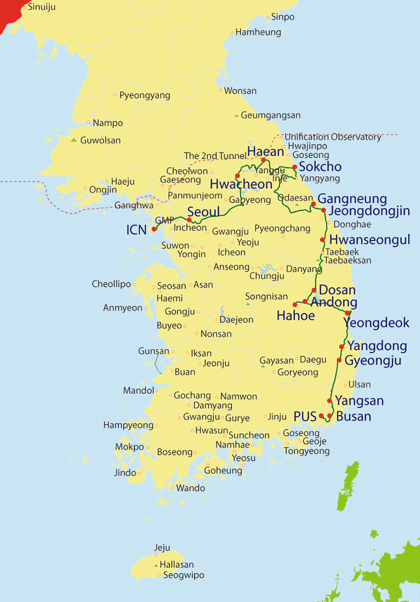 Day 1 Arrive Seoul (- - -)
Day 1 Arrive Seoul (- - -)
60km
Touching down at Incheon International Airport places you in the heart of Korea. After you clear Passport and Customs control, you will be welcomed by the tour guide and then transferred to your hotel.
Day 2 Seoul (B)
Your exploration this morning begins with a driving tour of Seoul, featuring sites such as Seoul Plaza, City Hall, Cheonggye Square and pedestrian-friendly Gwanghwamun Plaza that is hemmed in on both sides by rushing traffic and office buildings. The plaza is lined on each side with 365m long streamlets, two centimeters deep and one meter across, the stone bed of the plaza's east side waterway engraved with important events in chronological order from 1392 to 2008.
Standing high on a stone pillar is a statue of Yi Sunsin who had engaged in twenty-three naval battles and emerged victorious in all of them during the Hideyoshi invasion (1592-1598). King Sejong who propagated the Korean alphabet in the 15th century is also honored with prominent statue. On August 16, 2014, Pope Francis celebrated Mass in this plaza to beatify 124 Korean martyrs. Near the southwest corner of the plaza is Korea's Kilometer Zero, marking the distances to 64 cities around the world, including Seoul's antipode, Montevideo, Uruguay, 19,606km.
Step back in time to when life was gracefully slow and discover Gyeongbokgung Palace, a particularly charming spot that represents a colorful and turbulent side of the capital's 500-year history. Depending on timing, you may witness the Royal Guard Changing Ceremony featuring parade, password verification, duty shift and patrolling the gate. Accompanied by a court band with its colorful costumes and royal flags, the ceremony is performed daily basis at 10:00 and 14:00 except Tuesdays, although it is cancelled in case of rain or extremely hot or cold weather.
Up from the gates is a spacious stone-paved courtyard that is fully enclosed by wooden cloisters, and at the center of which runs three footpaths through two rows of rank stones, indicating the positions of the officials with the highest rank being closer to the hall.
Standing majestically on top of a two-tiered stone platform that is lined with detailed balustrades is Geunjeongjeon Hall, where the king formally granted audiences to his officials, gave declarations of national importance, presided over large official functions, and greeted foreign envoys and ambassadors. Check out the royal throne and a large painting, depicting sun, moon, five peaks, streams and pine trees, which was the crucial signifier of the king. And up in the center of the ceiling, the bright golden dragons in bold relief indicate the presence of the king.
At the back of the throne hall is a group of court offices. Displayed in front of the King's official quarters is sundial, conceived in order to catch the shadow of the sun, which tells time and 24 periods of seasonal change from the winter solstice to the summer solstice.
Sitting on the island in the rectangular lake is Gyeonghoeru. Supported by 48 square and cylindrical massive stone pillars representing the idea of Yin and Yang, this magnificent pavilion was used for many purposes ranging from receptions to national examinations.
Gangnyeongjeon is the king's sleeping and living quarters while Gyotaejeon is the queen's domain containing a number of halls. The noted feature of these main buildings is an absence of a top roof ridge.
Amisan Garden, landscaped with four hexagonal chimneys in orange bricks, is seldom noticed by the hurried visitors. Jagyeongjeon is the queen dowager's residence. Although less colorful, it is worth noting the wall, adorned with floral designs and the chimneys with ten longevity symbols.
Hyangwonjeong features a small pond with a manmade islet that supports a beautiful two-story pavilion. Behind this serene garden is Geoncheonggung, where the king and queen could relax in peace and quiet. It was here that the first electric lights in the country were installed in 1887 after 8 years of Thomas Edison's invention and a tragic chapter in Korea's history was recorded when empress Myeongseong was assassinated by the sword-bearing Japanese assassins in the early morning of 8 October 1895, allegedly under orders from Miura Goro.
Your visit to the National Folk Museum of Korea will familiarize you with wealthy culture of this friendly and picturesque nation. It is an excellent facility to illustrate the history of traditional life of the Korean people from the prehistoric age to the Joseon dynasty. The permanent exhibition features life and work, costumes and ornaments, handicrafts and technology, educations, living quarters, dietary life, oriental medicine, performing arts and games, beliefs and rituals, and
socio cultural life.
Insadong, at one time the center of traditional Korean art and antiques, features a mixture of historical and modern atmosphere representing the cultural glimpse of the nation. Clustered along the main street and alleys are lined with street vendors, wooden tea houses, restaurants and numerous galleries and shops dealing in antiques, oriental art supplies, and modern Korean art of all types and styles. Soak in the paintings, upscale artworks, antiques and potteries while you can. Get lucky and you just might meet the artist themselves. It can be plenty of fun walking on the main street, but you venture into the hidden alleys that do spring some unexpected surprises. While here, you may want to buy some souvenirs or simply wander and browse at leisure admiring cultural ambience.
Enjoy a brief visit to Gwangjang market. It is one of few markets retaining traditional Korean atmosphere. Established in 1905, the market today has 5,000 independent shops. On the market's ground level, the floor space is dominated by scores of small snack stalls selling rustic delicacies and cheap treats. Clouds of smoke billow out from the boiling pans, diverse types of pancakes sizzle on hot iron grills and the smell from the eateries filling the air. The roadside vendors hawking everything from food, fruits, vegetables to seafood and an entire upper level dedicated to high quality silk, satin, and linen. Try out some sorts of Korean snacks and see a side of regular Seoul life.
Drive past Cheonggyecheon Stream. After the Korean War (1950-1953), more people migrated into Seoul to make their living and settled down along the stream in shabby makeshift houses. The accompanying trash and waste, and deteriorating conditions resulted in an eyesore for the city. The stream was covered with layers of concrete in the mid 1950s and roadway until the massive urban renewal project freed it in 2005. Today, a 5.8km creek tumbles gently through downtown Seoul, providing a much needed source of peace and relaxation for the citizens of this fast-paced city.
You will also view Dongdaemun which once served as the east gate of Seoul and a block away is DDP of a distinctively neofuturistic design. Characterized by the "powerful, curving forms of elongated structures", it ramains as a major urban development landmark of Seoul.
Before you end the day's sightseeing, you will enjoy a panoramic view of Seoul over at N Seoul Tower observatory. Perched on top of Namsan Mountain, the tower tops out at 479.7m above sea level. It was constructed in 1975 as Korea's first integrated communication tower, transmitting TV and FM radio signals to the city and has now become a symbolic landmark of the capital. It is the absolute best place to enjoy the most enthralling vistas of Seoul. Near the tower base, you cannot possibly miss time capsule. Buried in 1985 under 15m of the ground, it holds 466 relics representing contemporary Korean lifestyle and culture. The capsule is scheduled to open five hundred years later in 2485. You will also witness thousands of Love Padlocks hanging from all sides, overwhelming the wire fence, without their keys to symbolize that their love for each other is forever. And Love Trees made of hundreds of locks are quite a sight to behold.
Day 3 Seoul - Hwacheon - Haean - Seoraksan (B) 300km
A pleasant journey through a picturesque countryside to Sokcho, once a sleepy fishing village that turned into the heart of Korea's most spectacular recreational areas. The road elevation from Hwacheon abruptly rises up and villages or farmlands are seldom seen, but only get the feeling of locked in the mountains. It generally has very light traffic volumes so the lack of development of this remote area.
Shortly after passing the Haesan tunnel built on the highest elevation in Korea, you will view the Peace Dam, 125m high and 601m long, that was completed in 2005. It was built to stave off possible catastrophic flooding should the upstream Imnam Dam in North Korea collapse, either intentionally or by accident. As it stands, the dam has no reservoir, and is merely preventive.
See World Peace Bell that was made from empty cartridge cases gathered from the world’s conflict zones in that it carries a significant meaning. The bell weights 37.5 ton but is incomplete. Check out a broken pigeon wing that is on display near the bell. It will be added bringing the bell complete on the day of day of unification of Korea.
The journey continues to Punch Bowl, a natural geologic bowl several kilometers across, ringed by steep mountains on four sides. The bowl creates the richest farmland, and the area is starkly beautiful. Many fierce battles were fought here during the Korean War because of its strategic location. The Battle of Bloody Ridge took place here from August to September 1951 and this was followed by the Battle of Heartbreak Ridge from September to October 1951, meanwhile the 1st Marine Division reinforced by the Korean Marine Corps Regiment captured the line of hills in the Battle of the Punchbowl from 31 August to 20 September 1951.
Take time to see Eulji Observatory and the 4th Tunnel. At the peak of the observatory, 1000 meters above sea level, enjoy the stunning 360 panorama of the Punch Bowl, including an ominous view of North Korea. Then, explore one of four known tunnels passing under the DMZ, dug secretly by the North. and check out a vivid hint of the surprise attack and to carry out future military operations against the South. Persons who suffer from claustrophobia, heart conditions or asthmatic symptoms are not allowed to enter the tunnel.
Seoraksan national park is a place that you can definitely find lots of outdoor activities to make it worthwhile for an extended stay. Rugged peaks, fantastic cliffs, numerous waterfalls, unique rock formations, and scenic valleys altogether make this park and surrounding area some of the most beautiful sceneries on the Korean peninsula, and give this area an unparalleled popularity around the year.
Day 4 Seoraksan (B)
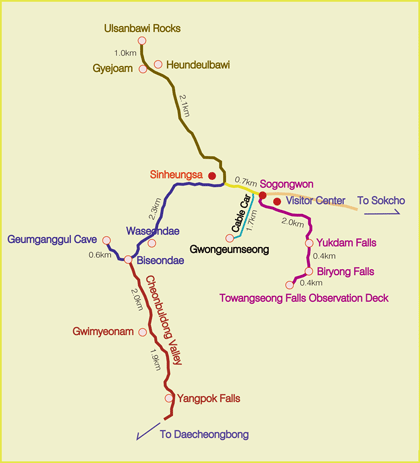 The word of the day is hiking of varying lengths and difficulty. All route types are out and back. Today, you will form your own independent tour to explore Seoraksan national park that has many different trails, and you are free to pick and choose which ones you want to do.
The word of the day is hiking of varying lengths and difficulty. All route types are out and back. Today, you will form your own independent tour to explore Seoraksan national park that has many different trails, and you are free to pick and choose which ones you want to do.
Only a small walk from the park entrance (Sogongwon), you will marvel at a large bronze statue, Unification Buddha, symbolizing Korean people's hope for reunification of the country. A little further on is Sinheungsa temple which claims to be the Korea's oldest Zen temple. Left trail in the direction of the temple is a trailhead of Cheonbuldong valley, the most impressive valley in the park, leading finally to the Daecheongbong peak of Seoraksan (1,708m), while right trail is up to Ulsan Bawi Rocks.
Among the most recommendable trails from Sogongwon are as follow and the given times below are based on round trip in a bit relaxed pace.


Cheonbuldong valley Trail
One hears many legends of the heavenly nymphs who come down to play at Biseondae while taking a bathe in the placid pools of the valleys that are hidden from the human eyes. Near Biseondae rises Janggunbong majestically and among the crags of it is a temple alcove, Geumgang cave. You may want to head up a very steep incline for 600m from the gentle slope of the trail, and you can scale only by carefully ascending the long, steep, metal stairs bolted onto the sheer cliff face. The hike, although hard, comes with a stunning view of numerous cliffy peaks and mountain valley. From Biseondae, another 3.5km to Yangpok Falls, so spacious yet everywhere you looked you are surrounded by giant mountain peaks.

Ulsanbawi Rocks Trail
About an hour and half into the walk from the park entrance is Gyejoam hermitage. Located at the base of Ulsanbawi, and the point at which the trail takes a sharp rise upwards. In front of the hermitage on a spacious stone slab is a huge spherical rock called Heundeulbawi. This rock is soperfectly balanced that it can be shaken with some effort, but nobody gets further than waggling it. Your adventure begins by climbing a massive steep staircase that winds its way up the side of the cliff that angle up Ulsanbawi which is in a folding screen shape made up of cliffs on all sides. It is a 1.8km-long ridge of naked, gray stone peaks jutting well over 800m into the sky.

Biryong waterfall Trail
The trail is relatively easy for anyone to try and you will view Biryeong waterfalls at the trail end. About 400m further above the falls, you will be amazed at Towangseong waterfalls cascading down a 320-meter cliff.
Cable Car
There is a cable car that picks you up at the valley floor to the Gwongeumseong. The peak is surrounded by cavernous drop-off cliffs, cloaked in more towering rocky summits. Definitely, you stand in awe on the top: sweeping panoramic views of the park around you, the Pacific Ocean, and the small beachside town of Sokcho. Be careful as always as there is not much room to move about and people constantly going up and down and moving around.
Hiking Trails
1. Biryong Falls (4.8km): 2 hours - Walking on a trail and suitable for whole family
2. Biryong Falls + Towangseong Falls Observation Deck (5.6km): 3 hours 30 minutes - Serious hiking from Biryong Falls to the observation deck
3. Biseondae (6km): 3 hours - Walking on a trail and suitable for whole family
4. Biseondae + Geumgang cave (7.2km): 4 hours 30 minutes - Very strenuous hiking from Biseondae to the cave
5. Biseondae + Yangpok (13.8km): 7 hours - Walking on a trail and no use of hands
6. Heundeulbawi (5.6km): 3 hours - Walking on a trail and no use of hands.
7. Heundeulbawi + Ulsanbawi (7.6km): 5 hours 30 minutes - Very strenuous hiking from Heundeulbawi
8. Gwongeumseong Cable car (3.4km): 1 hour (roughly four minutes each up and down)
Sokcho has so much more to offer than just mountains. Daepohang becomes a great attraction when this small alley lit up. You will see a wide variety of fresh seafood harvested from the nearby sea and a number of small restaurants serving sliced raw fish. You will find something to enjoy, from simply feeling the ambiance of this small fishing port to taking picture. And in downtown, there is a colorful market selling fishes, fruits, vegetables, grains and daily necessities, and a little further down is a North Korean refugee village that can be accessible by a hand-pulled boat.
Day 5 Seoraksan - Yangyang - Girin - Jinbu - Gangneung (B) 220km
Today, you will enjoy a rugged beauty of a mountain and spectacular view as you travel through a narrow road that wove up the Hangyeryeong pass in steep switchbacks. Then, the journey continues along the Naerincheon, the only river that flows north in Korea, and enjoy Misan Valley, Saldun Valley and Unduryeong pass. Flowing down the forested mountainside of the river, the waters are clean and clear, offering a balance of high, rough rapids and smooth, gentle rapids. Few people go there because it is hard to reach.
It is more beautiful, for it has various faces according to the changes in seasons. When spring comes, the thick ice of the valleys starts to melt and a type of salmon starts to swim upstream to lay eggs. When you notice scarlet royal azaleas blossom along the stream and the water becomes cobalt blue, you can say summer has come. When fall comes in the valley, color leaves reflected on the surface of the stream seem to dye the water red and yellow. Winter in the valley has a short temper, so it doesn’t wait until December. You can see white snow sparkling all over the valley in early November. When you see this magnificent sight, you have no choice but to be spellbound.
You will tour the 7th century Woljeongsa temple. You will pass under the Boje-ru, which is adorned with various guardians to gain access to the temple courtyard. Straight ahead, you will immediately notice the nine-story, octagonal shaped, stone pagoda from the Goryeo Dynasty. The uniquely shaped pagoda is not only the main highlight to the temple, but it’s also National Treasure. Wind chimes hang on each corner of the pagoda, while a seated stone Bodhisattva is situated out in front making an offering. Another amazing part of the temple is the 800-meter path arched by tall fir trees. The trickles of stream and fresh yet musky fir trees small add the pleasure of your visit.
While in Gangneung, visit Gyeongpodae, a charming beach loved by many. There is a Chamsori museum featuring 170 phonographs, some of which are invented by Thomas A. Edison (1847-1931) himself and several other antique items.
Day 6 Gangneung - Jeongdongjin - Dosan - Andong (B) 220km
Drrive past the salvaged North Korean submarine that is on display together with retired Korean navy ship. The three armed guerillas infiltrated into the land on September 15, 1996, to spy on the naval installations in the area while the others were on standby in the submarine. However, it ran aground on September 18. The crew eventually abandoned any attempt to find their way back to the North and split up in several groups. But, one was soon spotted by a civilian who became suspicious and alarmed the authorities. Counterespionage operation was in progress for 49 days and of the 26 North Korean infiltrators, 1 was captured alive, 13 spies were shot, 11 were murdered by their colleagues and 1 reportedly escaped back to North Korea.
After a short break at Jeongdongjin, a tiny village located by the ocean with a quaint railway station of being the closest to the ocean anywhere in the world, explore Hwanseongul Cave. About 30 minute grueling uphill hike from the ticket office or a 6 minute on a mono rail gets you to a cave entrance of overwhelming size in the middle of the mountain. The cave itself is super massive and it would take well over one hour to explore. Be prepared for wet walkways, maneuvered up a narrow corridor with a rapidly flowing creek below it and hung off the side of the cave's walls above the creek. Many waterfalls are actively eroding the floor. Only 1.6km open to the public; yet that section alone will provide unforgettable memories. Cave tour is absolutely at your choice. You could opt out by staying outside, or simply relax.
Tour includes Dosan Seowon, a Confucian-shrine academy which was established in 1574 in memory of Yi Hwang (1501-1570) who introduced Neo-Confucianism into Korea. The facility is composed of 16 buildings most of which were built in a simple and concise style. About hundreds of Seowon were functioning by the early 1800s, but then most of them were destroyed around 1870 by the court order. Dosan Seowon is among some of the few survived academies. Although the educational function of the facility has long since ceased, but you can feel Confucian ideology and value that has deeply influenced the lives of Koreans in all aspects.
Day 7 Andong - Hahoe - Yeongdeok - Pohang - Gyeongju (B) 230km
Andong is a stronghold of Confucianism. Explore UNESCO World Heritage Site, Hahoemaeul from the 15th century. It is the best preserved traditional village portraying and spanning the life of the Joseon Dynasty (1392-1910) and some 480 Korean traditional houses, both large and small, are still fully functioning. As you take a walk in the narrow alleys, enjoy the rustic and old charm of this unique village. You cannot possibly miss a 600-years old zelkova tree, the home to the village spirit. At the tree's base is where residents still make their wishes. The village is also known for traditional festival, Hahoe Mask Dance which gave common people the opportunity to mock those in authority, and in particular the Byeolsingut, a shaman ritual exorcising evil spirits, dating back to the Goryeo dynasty (918-1392).
En route, stop off at Yeongdeok, a charming but quiet town safely removed from the tourist trail. Yeongdeok is highlighted with Ganggu wharf, best known as the trade center of snow crab in Korea. While here, you will get to learn how the crabs are brought into the port to the sight of thousands of them laid out on the ground. This small port is busy every morning with dozens of aquarium cars for live fish available for sale. The alley is packed with many restaurants serving snow crabs. Trying them here is a special treat and an exceptional experience.
While in Pohang, explore Jukdo fish market, displaying a huge variety of fish and shellfish including the Pacific herring used to make Gwamegi. It is a remarkable place filled to the brim with exotics. An amazing array of seafood - both fresh and processed. Here you can see just about every stage of the fishing trade, from when the fish are off-loaded to when they’re eaten in the shops behind the stalls. Sannakji is octopus that’s so fresh it still wriggles as you chew it. The market is really a visual and culinary treat.
Gyeongju is one of the ten most historically significant sites in the world with ancient temples, weathered stone pagodas, royal tombs, Buddhist bas-reliefs, and fortress ruins. Today, you are treated to an ancient capital of the Silla dynasty (BC57-AD935) often dubbed as Museum without Walls.
Day 8 Gyeongju (B)
With a full day to further explore the delights of UNESCO World Heritage Site, Seokguram grotto. It is the home of the serene stone Buddha of the eighth century. Inside, a white statue of a seated Buddha in a sublime state of enlightenment, is surrounded by 37 relief figures of Bodhisattvas, disciples, devas, and guardian kings. The grotto represents the magnificent harmony of religion, science and the arts of Buddhism, symbolizing the pure land in which Buddha resides.
A short ride leads you to another UNESCO World Heritage Site, Bulguksa temple, where you will witness the impressive gates, symbolic bridges leading up to the world of Buddha, graceful architectures, Three-storied Seokgatap and highly ornate Dabotap blending well into the architectural harmony.
At Gwaneumjeon hall, check out the image of the Avalokitesvara who is referred to as the Bodhisattva of Compassion and has a thousand hands, and eyes in each so as to reach out to those in need of help. You will see a gilded statue of Vairocana with the gesture of the first wisdom, Sakyamuni Buddha along with sixteen figures of Buddha's disciples sitting in deep meditation, and a gilt-bronze Amitabha Buddha who is the ruler of the Western Paradise Sukhavati. The architectural design of Bulguksa is one of constrained dignity, peace, and harmony and the temple still remains one of the most remarkable achievements of the ancient Far East.
The Gyeongju Historic Areas contain a remarkable concentration of outstanding examples of Korean Buddhist art, in the form of sculptures, reliefs, pagodas, and the remains of temples and palaces from the flowering, in particular between the 7th and 10th centuries, of this form of unique artistic expression.
Visit Gyeongju National Museum for a great insight into Silla culture and history. The first thing that you will notice is The Bell of King Seongdeok, the largest extant bell in Korea. You must certainly stand in awe before the bell from the 8th century with such artistic beauty of design. The bell is distinguished not only for its outstanding beauty but also for its long reverberating sound, the incredibly precise casting technique, in addition to the sad legend surrounding it. On entering the museum, you will marvel at the priceless archaeological and historical artifacts including splendid gold crowns, earrings, belts, ornaments, glassware, potteries, and clay figures as well as a royal barge.
Afterwards, explore Donggung palace and Wolji pond, a pleasure garden built to commemorate the victory of Silla, and later used as the recreational area for the Silla's royal family, then followed by a relaxed walking tour covering the ruins of Banwolseong or half moon fortress where Silla palace and eight fortress gates stood. There is a Seokbinggo, a freezer made of stones. Half of the structure is underground while the other half is above ground with three air vents on top. You can feel the cold oozing out of this simple structure. Near fortress is Gyerim, literally meaning Rooster Forest. It is a sacred woodland area where progenitor of the Gyeongju Kim family, Kim Alji, was supposed to have been born.
Then, check out the world's oldest existing astronomical observatory, Cheomseongdae. Each stone used in the observatory bears symbolic meaning; the same number of the days of the year by lunar calendar, the number of the major stars, the months of the year and the numbers of the seasonal divisions. Nearby Tumuli Park encompasses 23 huge tomb mounds where Silla rulers were buried. One of the tombs, Cheonmachong, is opened to the public and you can go inside and see how the tombs were made and replicas of the treasures excavated in 1973.
The tour also covers Bunhwangsa temple with 10m-high three-storied rectangular pagoda, the main worship hall with Buddha of Medicine, and legendary well that is said to have saved the kingdom. The nearby open field was once occupied by Silla's largest temple Hwangyongsa. The 67m tall nine-storied pagoda made entirely of wood stood here until it was destroyed during the Mongol invasion in 1238.
Day 9 Gyeongju - Yangsan - Busan (B) 110km
Travel to Busan, Korea's second largest city surrounded by the ocean on one side, and mountains on the other. Its deep harbor and gentle tides have allowed it to grow into the largest port in Korea and the fifth largest in the world. It is also a center of industry and commerce, a thriving metropolis formed unusually long in shape along its coastal line.
En route, visit the 7th century Tongdosa, representing the Temple of the Buddha. The approach to the temple is completely entrancing. Magnificently set by a lane of pine trees dancing in the wind and beside which a mountain stream sings a babbling song, a distinctive and exalting place. The main worship hall is unique in that it does not contain a statue of the Buddha, but rather a window looking out onto the Diamond Precepts Altar with a bell-shaped stupa that contains the cremated remains of the Buddha himself. You will find the temple more like a museum as it houses many local treasures and cultural properties.
Squeeze in a stop at Haeundae, a world-class beach resort blessed by beautiful water and screened by skyscrapers along the beautifully curved coastline. Afterward, cross the Suyeong Bay over Gwangan Bridge, installed with over 10,000 colorful LED lights which sparkle brightly under the night skies.
Visit UN memorial cemetery where 2,334 deceased soldiers from fourteen Korean War allies rest in honored serenity. Learn about the Korean War and pay tribute to those who dedicated their lives to the World Peace. During the period of 1951-1954, remains of approximately 11,000 fallen of the UN Forces were buried here. Thereafter, most were repatriated to their home countries. In the cemetery, lie the remains of Korean War heroes from Australia(281), Belgium(1), Canada(382), Colombia(4), France(47), Netherlands(124), New Zealand(32), Norway(1), Republic of Korea(39), South Africa(11), Thailand(1), Turkiye(462), United Kingdom(892), United States of America(41) Unknown and others(16).
You will tour Yongdusan Park where Busan Tower sits atop a hillock of a steep slope, affording 360-degree views of the hilly terrain of this mountainous coastal city and the harbor. Smack dab in the middle of the park stands the statue of Yi Sunsin, who is credited with the perfection of the first iron-clad warship in history. You will also see a flower clock and a Busan citizen's bell that they ring on New Years' Day, March 1 and August 15.
Just off the park is Gwangbokro Street, full of shops selling everything from bargains to luxury items. Adjacent is a maze of small streets alive with color, sidewalks sprinkled with unique shops and local eateries. Enjoy the vibrant ambience as you leisurely make your way to the BIFF square, Busan’s modern movie district having hand prints of the famous movie stars and directors on the sidewalk, movie theaters, trendy shops and street food stalls. The area with originally little more than a pair of cinemas that were built over half a century ago had turned into the newly transformed district, and was named BIFF Square on August 14, 1996.
Across the street from the square is a fascinating Jagalchi fish market, a great attraction located dockside. Here you will find a diverse array of seafood on display as you walk along the narrow alleys of street vendors. A nearby indoor market features live fish in the tanks and the upstairs are dried fish along with many restaurants selling raw fish at reasonable prices. The market is really a visual and culinary treat.
Day 10 Busan - Departure (B)
After this wonderful trip exploring Korea and with time to reflect on your surprise in your experience, transfer to Gimhae international airport or Busan International Ferry Terminal in time for your departure. By boarding, you are already far off Busan heading for home.





